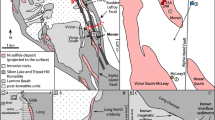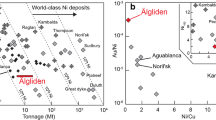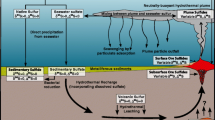Abstract
The suggestion that Sudbury-type ores may be formed by the introduction of country rock sulfur into still hot intrusions (i.e., sulfurization) suffers from a reputed lack of field evidence. Permissive evidence for sulfurization includes the epigenetic nature of many Sudbury-type ores and that many Sudbury-type ores crystallized from sulfide melts. Visual evidence exists for sulfurization of a gabbro in Zambia. The lead isotopic composition of ore minerals at Sudbury implies that at least some of the metals were derived from the erruptive. Published sulfur isotopic data from several Sudbury-type ores differ from and do not exhibit a common pattern of isotopic enrichment with respect to sulfides within associated intrusions. Evidently the sulfur was derived from the country rocks. Sudbury-type ores exhibiting magmatic textures commonly occur within more siliceous dikes than the host intrusions. Inorganic reduction of sulfate occurs only above 600° C. Reduction of sulfate with resultant sulfurization of ferrous iron and traces of other metals originally present in the still hot parental intrusive rock would make the rock more siliceous. Above 1100° C the silicate-residue and newly formed sulfides would form immiscible magmas. Therefore, ore magmas within and near mafic intrusives can be epigenetic. The processes by which sulfur is introduced into intrusions are still speculative.
Zusammenfassung
Für die Annahme, daß Erze vom Sudbury-Typus sich durch Zuführung von Nebengesteinsschwefel in noch heiße Intrusionen bilden können (“sulfurization”), fehlt es angeblich an Feldunterlagen. Folgende Tatsachen lassen sich mit einer Schwefelung (“sulfurization”) vereinigen: der epigenetische Charakter vieler Erze vom Sudbury-Typ; auch sind viele Erze von Sudbury-Typus aus sulfidischen Schmelzen kristallisiert. In einem Gabbro in Zambia ist der Beweis für Schwefelung (“sulfurization”) direkt sichtbar. Die Isotopen-Zusammensetzung von Blei in Erzmineralien in Sudbury zeigt, daß mindestens einige der Metalle aus dem Eruptivgestein stammen. Schwefelisotop-Daten, die für mehrere Lagerstätten von Sudbury-Typen veröffentlicht worden sind, haben hinsichtlich der Isotop-Anreicherung keine gemeinsamen Züge. Offensichtlich stammt der Schwefel aus dem Nebengestein. Erze vom Sudbury-Typ mit magmatischem Gefüge finden sich oft in Gängen, die saurer sind als das Wirtsgestein. Anorganische Reduktion von Sulfat findet nur oberhalb 600°C statt. Reduktion von Sulfat und die entstehende Schwefelung (“sulfurization”) von zweiwertigem Eisen und Spuren anderer Metalle, die ursprünglich in dem noch heiß eruptiven Gestein anwesend sind, machen das Gestein noch saurer. Oberhalb 1100°C würden der Silicat-Rest und die neugeformten Sulfide nicht mischbare Magmen bilden. Deshalb können sich sulfidische Schmelzen innerhalb und in der Nähe von “Mafic”-Intrusionen später gebildet haben. Die Prozesse, durch die Schwefel in Intrusionen eingeführt wird, sind noch unbekannt.
Similar content being viewed by others
References
Aho, A.E.: Geology and genesis of ultrabasic nickel-copper pyrrhotite deposits at the Pacific Nickel property, southwestern British Columbia. Econ. Geol. 51, 441–481 (1956).
Ault, W.V., and J.L. Kulp: Isotopic geochemistry of sulphur. Geochim. Cosmochim. Acta 16, 201–235 (1959).
Bateman, A.M.: Magmatic ore deposits, Sudbury, Ont. Econ. Geol. 12, 391–426 (1917).
Berry, L.G., and B. Mason: Mineralogy, 630 p. San Francisco: W. H. Freeman & Co. 1959.
Burrows, A. G., and H. C. Rickaby: Sudbury nickel field restudied. 43rd Ann. Rept. Ontario Dept. Mines 43, part II, 43 p. (1934).
Campbell, F.A.: Nickel deposits in the Quill Creek and White River areas, Yukon. Can. Mining Met. Bull. 53, 953–959 (1960).
Cameron, E.N.: Origin of sulfides in the nickel deposits of Mount Prospect, Connecticut. Geol. Soc. Am. Bull. 54, 651–686 (1943).
Carithers, W., and A. K. Guard Geology and ore deposits of the Sultan Basin, Snohomish County, Washington. Wash. Div. Mines Geol. Bull. 36, 90 p. (1945).
Clark, L.A.: Geology and geothermometry of the Marbridge nickel deposit, Malartic, Quebec. Econ. Geol. 60, 792–811 (1965).
Clauson, V. C.: Geology of the Sudbury Basin area, Ontario, Canada. Unpublished. University of Washington Ph. D. dissertation, 135 p. (1947).
Coleman, A. P.: The Sudbury Nickel field. Ontario Bur. Mines Rept. 14, pt. 3, 188 p. (1905).
— Magmas and sulfide ores. Econ. Geol. 12, 427–434 (1917).
--, E. S. Moore, and T. L. Walker: The Sudbury nickel intrusive. Contributions to Canadian Mineralogy, 1929; Univ. Toronto Studies, Geol. Ser., 28, 54 p. (1929).
Collins, W.H.: The life history of the Sudbury nickel irruptive, Part 4. Roy. Soc. Canada Trans. 3rd ser., sec. IV, 31, 15–43 (1937).
Cooke, H. C.: Problems of Sudbury geology, Ontario. Canada Geol. Survey Bull. 3, 77 p. (1946).
Craig, J. R.: Appearance of phases during cooling of pyrrhotite-rich Ni-Cu ores. 1965–1966 Ann. Rept. Dir. Geophys. Lab., Carnegie Inst., Washington, p. 335–336, (1967).
Davies, J.F.: Copper-nickel deposits of the Bird River area. Western Miner and Oil Rev. 28, No. 8, 42–44 (1955).
Desborough, G.A.: The significance of accessory magmatic sphalerite in basic rocks to the origin of nickeliferous pyrrhotite ores. Econ. Geol. 61, 370–375 (1966).
Fitzhugh, Jr., E.F., and D.C. Seidel: Formation of nickel and iron sulfides from silicates at moderate temperatures (abs.). Geol. Soc. Am. 1966 Ann. Meetings, Program, 68 (1966).
Garlick, W.G.: Hydrothermal versus syngenetic theories of ore deposition. Econ. Geol. 58, 447–456 (1963).
Godlevskii, M.N.: Problems of genesis of the copper-nickel deposits of the Siberian platform: Geol. of Ore Deposits (Geologiya. Rudnykh Mestorozhdenii); Acad. Sci. U.S.S.R. 1, No. 2, 16–30 (1959). Abstracted and translated by E. A. Alexandrov. Econ. Geol. 56, 448–449 (1961).
—, and L.N. Grinenko: Some data on the isotopic composition of sulfur in the sulfides of the Noril'sk deposit. Geochemistry (USSR) (English Transl.) 1, 35–41 (1963).
Haapala, P.S.: Fennoscandian nickel deposits (abs.). Econ. Geol. 61, 802–803 (1966).
Hawley, J.E.: Upside-down zoning at Frood, Sudbury, Ontario. Econ. Geol. 60, 529–575 (1965).
Horwood, H.C.: Magmatic segregation and mineralization at the B. C. Nickel mine, Choate, B. C. Roy. Soc. Canada Trans. 3rd. ser., sec. IV, 31, 5–14 (1937).
Howe, E.: Petrographical notes on the Sudbury nickel deposit. Econ. Geol. 9, 505–522 (1914).
Jensen, M.L.: Sulfur isotopes and mineral paragenesis. Econ. Geol. 52, 269–281 (1957).
— Sulfur isotopes and hydrothermal mineral deposits. Econ. Geol. 54, 374–394 (1959).
Karpov, R.V.: Pegmatites of basic rocks in Monchetundra and the associated sulfide mineralization: Geol. of Ore Deposits (Geologiya Rudnykh Mestorozhdenii). Acad. Sci. U.S.S.R. 1, No. 5, 74–90 (1959); abstracted and translated by E. A. Alexandrov. Econ. Geol. 56, 1004 (1961).
Kennedy, G.C.: Some aspects of the role of water in rock melts. Geol. Soc. Am. Spec. Papers 62, 489–504 (1955).
Kullerud, G., and H. S. Yoder: Sulfide-silicate relations. 1962–1963 Ann. Rept. Dir. Geophys. Lab. Carnegie Inst. Washington, 215–218 (1963).
-- Sulfide-silicate reactions. 1963–1964 Ann. Rept. Dir. Geophys. Lab., Carnegie Inst., Washington, 218–222 (1964).
Lovering, T.S.: Epigenetic, diplogenetic, syngenetic, and lithogene deposits. Econ. Geol. 58, 315–331 (1963).
MacNamara, J., W. Fleming, A. Szabo, and H.G. Thode: The isotopic constitution of igneous sulphur and the primordial abundance of the terrestial sulphur isotopes. Can. J. Chem. 30, 73–76 (1952).
Mills, J.W.: Geologic setting of the nickel occurrences of Jumbo Mountain, Washington. Min. Engineering 12, 272–274 (1960).
Naldrett, A.J.: The role of sulphurization in the genesis of iron-nickel sulphide deposits of the Porcupine district, Ontario. Can. Mining Met. Bull. 59, 489–497 (1966).
--, and G. Kullerud: Investigations of the nickelcopper ores and adjacent rocks of the Sudbury district, Ontario. 1964–1965 Ann. Rept. Dir. Geophys. Lab., Carnegie Inst., Washington, 177–188 (1965).
-- Investigations of the nickel-copper ores and adjacent rocks of the Strathcona mine, Sudbury district, Ontario. 1965–1966 Ann. Rept. Dir. Geophys. Lab., Carnegie Inst., Washington, 302–320 (1967).
Pelzer, E.E.: The Rankin-Inlet nickel-copper deposit. Can. Mining J. 71, No. 9, 79–83 (1950).
Ruttan, G.D.: Geology of Lynn Lake. Can. Mining Met. Bull. 48, 339–348 (1955).
Sales, R.H., and C. Meyer: Wall rock alteration at Butte, Montana. Am. Inst. Mining Met. Engs. Trans. 178, 9–35 (1949).
Scholtz, D.I.: The magmatic nickeliferous ore deposits of East Griqualand and Pondoland, Pretoria: Univ. Pretoria Pub., Series II. Nat. Sci. 1, 81–210 (1936). Abstracted in Annotated Bibliog. Econ. Geol. 9, No. 2, 287 (1936).
Shields, W.R., S.S. Goldich, E.L. Garner, and T.J. Murphy: Natural variations in the abundance ratio and the atomic weight of copper. Jour. Geophys. Res. 70, 479–491 (1965).
Shima, M., W. Gross, and H.G. Thode: Sulfur isotope abundances in basic sills, differentiated granites, and meteorites. J. Geophys. Res. 68, 2835–2847 (1963).
Skinner, B.J., and D.L. Peck: The solubility of sulfur in basic magmas (abs.). Econ. Geol. 61, 802 (1966).
Smith, L. L.: Magnetite deposits of French Creek, Pennsylvania: Penna. Geol. Surv. Bull. M 14, 4th ser., 52 p. (1931).
Smitheringale, W.G., and M.L. Jensen: Sulfur isotopic composition of the Triassic igneous rocks of the eastern United States. Geochim. Cosmochim. Acta 27, 1183–1207 (1963).
Souch, B.E.: The sulfide ores of Sudbury: their particular relation to a distinctive inclusion-bearing facies of the “nickel irruptive” (abs.). Econ. Geol. 61, 801 (1966).
Spencer, A. C.: Magnetite deposits of the Cornwall type: U.S. Geol. Surv. Bull. 359, 102 p. (1908).
Stanton, R.L., and R.D. Russell: Anomalous leads and the emplacement of lead sulfide ores. Econ. Geol. 54, 588–607 (1959).
Thode, H.G., H.B. Dunford, and M. Shima: Sulfur isotope abundances in rocks of the Sudbury district and their geological significance. Econ. Geol. 57, 565–578 (1962).
Turekian, K.K., and K.H. Wedepohl: Distribution of the elements in some major units of the Earth's crust. Geol. Soc. Am. Bull. 72, 175–192 (1961).
Turner, F.J., and J. Verhoogen: Igneous and metamorphic petrology (2nd ed.) 694 p. New York: McGraw-Hill 1960.
Vinogradov, A.P., and V.I. Grinenko: The effect of enclosing rocks on the isotopic composition of sulfur in sulfide ore minerals. Geochim. Internat. 1, 468–474 (1964).
—, M.S. Shupakhin, and V.A. Grinenko: Some data on the isotopic composition of sulfur in sulfides. Geochemistry (USSR) (English Transl.) 3, 221–225 (1957).
Wager, L.R., E.A. Vincent, A.A. Smales, and P. Batholome: Sulfides in the Skaergaard intrusion, East Greenland. Econ. Geol. 52, 855–903 (1957).
Wilson, H.D.B., and W.C. Brisbin: Regional structure of the Thompson-Moak Lake nickel belt. Can. Inst. Min. Metall. Trans. 64, 470–477 (1961).
Zontov, N.S.: The geological structure of the copper-nickel deposit of the northern part of Rudnaya Mountain (Noril'sk region): Geol. of Ore Deposits (Geologiya Rudnykh Mestorozhdenii): Acad. Sci. U.S.S.R. 1, No. 5, 3–20 (1959); abstracted and translated by E. A. Alexandrov. Econ. Geol. 56, 1001 (1961).
Zurbrigg, H.F.: Thompson mine geology. Can. Mining Met. Bull. 56, 451–460 (1963).
Author information
Authors and Affiliations
Rights and permissions
About this article
Cite this article
Cheney, E.S., Lange, I.M. Evidence for sulfurization and the origin of some sudbury-type ores. Mineral. Deposita 2, 80–94 (1967). https://doi.org/10.1007/BF00206581
Published:
Issue Date:
DOI: https://doi.org/10.1007/BF00206581




